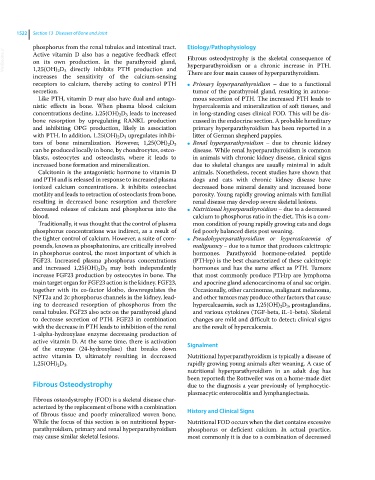Page 1584 - Clinical Small Animal Internal Medicine
P. 1584
1522 Section 13 Diseases of Bone and Joint
phosphorus from the renal tubules and intestinal tract. Etiology/Pathophysiology
VetBooks.ir Active vitamin D also has a negative feedback effect Fibrous osteodystrophy is the skeletal consequence of
on its own production. In the parathyroid gland,
hyperparathyroidism or a chronic increase in PTH.
1,25(OH) 2 D 3 directly inhibits PTH production and
increases the sensitivity of the calcium‐sensing There are four main causes of hyperparathyroidism.
receptors to calcium, thereby acting to control PTH ● Primary hyperparathyroidism – due to a functional
secretion. tumor of the parathyroid gland, resulting in autono
Like PTH, vitamin D may also have dual and antago mous secretion of PTH. The increased PTH leads to
nistic effects in bone. When plasma blood calcium hypercalcemia and mineralization of soft tissues, and
concentrations decline, 1,25(OH) 2 D 3 leads to increased in long‐standing cases clinical FOD. This will be dis
bone resorption by upregulating RANKL production cussed in the endocrine section. A probable hereditary
and inhibiting OPG production, likely in association primary hyperparathyroidism has been reported in a
with PTH. In addition, 1,25(OH) 2 D 3 upregulates inhibi litter of German shepherd puppies.
tors of bone mineralization. However, 1,25(OH) 2 D 3 ● Renal hyperparathyroidism – due to chronic kidney
can be produced locally in bone, by chondrocytes, osteo disease. While renal hyperparathyroidism is common
blasts, osteocytes and osteoclasts, where it leads to in animals with chronic kidney disease, clinical signs
increased bone formation and mineralization. due to skeletal changes are usually minimal in adult
Calcitonin is the antagonistic hormone to vitamin D animals. Nonetheless, recent studies have shown that
and PTH and is released in response to increased plasma dogs and cats with chronic kidney disease have
ionized calcium concentrations. It inhibits osteoclast decreased bone mineral density and increased bone
motility and leads to retraction of osteoclasts from bone, porosity. Young rapidly growing animals with familial
resulting in decreased bone resorption and therefore renal disease may develop severe skeletal lesions.
decreased release of calcium and phosphorus into the ● Nutritional hyperparathyroidism – due to a decreased
blood. calcium to phosphorus ratio in the diet. This is a com
Traditionally, it was thought that the control of plasma mon condition of young rapidly growing cats and dogs
phosphorus concentrations was indirect, as a result of fed poorly balanced diets post weaning.
the tighter control of calcium. However, a suite of com ● Pseudohyperparathyroidism or hypercalcaemia of
pounds, known as phosphatonins, are critically involved malignancy – due to a tumor that produces calcitropic
in phosphorus control, the most important of which is hormones. Parathyroid hormone‐related peptide
FGF23. Increased plasma phosphorus concentrations (PTHrp) is the best characterized of these calcitropic
and increased 1,25(OH) 2 D 3 may both independently hormones and has the same effect as PTH. Tumors
increase FGF23 production by osteocytes in bone. The that most commonly produce PTHrp are lymphoma
main target organ for FGF23 action is the kidney. FGF23, and apocrine gland adenocarcinoma of anal sac origin.
together with its co‐factor klotho, downregulates the Occasionally, other carcinomas, malignant melanoma,
NPT2a and 2c phosphorus channels in the kidney, lead and other tumors may produce other factors that cause
ing to decreased resorption of phosphorus from the hypercalcaemia, such as 1,25(OH) 2 D 3 , prostaglandins,
renal tubules. FGF23 also acts on the parathyroid gland and various cytokines (TGF‐beta, IL‐1‐beta). Skeletal
to decrease secretion of PTH. FGF23 in combination changes are mild and difficult to detect; clinical signs
with the decrease in PTH leads to inhibition of the renal are the result of hypercalcemia.
1‐alpha‐hydroxylase enzyme decreasing production of
active vitamin D. At the same time, there is activation Signalment
of the enzyme (24‐hydroxylase) that breaks down
active vitamin D, ultimately resulting in decreased Nutritional hyperparathyroidism is typically a disease of
1,25(OH) 2 D 3 . rapidly growing young animals after weaning. A case of
nutritional hyperparathyroidism in an adult dog has
been reported; the Rottweiler was on a home‐made diet
Fibrous Osteodystrophy due to the diagnosis a year previously of lymphocytic‐
plasmacytic enterocolitis and lymphangiectasia.
Fibrous osteodystrophy (FOD) is a skeletal disease char
acterized by the replacement of bone with a combination
of fibrous tissue and poorly mineralized woven bone. History and Clinical Signs
While the focus of this section is on nutritional hyper Nutritional FOD occurs when the diet contains excessive
parathyroidism, primary and renal hyperparathyroidism phosphorus or deficient calcium. In actual practice,
may cause similar skeletal lesions. most commonly it is due to a combination of decreased

